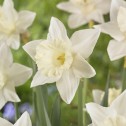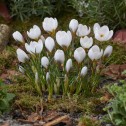The Mythology of Flower Bulbs
- News
- 559 views

Flower bulbs, with their ability to lie dormant underground and then bloom in vibrant colours, have fascinated cultures for centuries, leading to myths and stories centered around themes of rebirth, mystery, and transformation. Unlike plants that continually grow and change with the seasons, bulbs seem to “resurrect” after periods of dormancy, which has inspired many symbolic interpretations. Here’s an exploration of the mythology surrounding some of Boston Bulbs’ bestselling and favourite flower bulbs.
Tulips- Love and Sacrifice
Persian Mythology: In Persian legend, tulips are associated with passionate love and heartbreak. One popular story tells of a young man named Farhad, who was in love with a beautiful woman named Shirin. When he heard false news of her death, he was so heartbroken that he took his own life. Legend says that red tulips sprang up from each drop of his blood, symbolising the depth of his love. To this day, red tulips represent true, undying love in Persian culture.
European Folklore: In Europe, tulips became a symbol of wealth and status during the “Tulip Mania” in the Netherlands in the 17th century. The rarity of certain tulip bulbs made them precious and almost sacred. Tulip bulbs were even treated as prized heirlooms, passed down within families and treasured for their beauty and symbolic value.
Daffodil (Narcissus)- Vanity and Transformation
Greek Mythology: The daffodil is often associated with the myth of Narcissus, a young man known for his beauty. He fell in love with his own reflection in a pool of water, eventually wasting away as he was unable to look away. According to the myth, the gods turned him into a daffodil flower, which grows near water, with its face often bending toward its reflection. The story of Narcissus embodies themes of self-love, vanity, and transformation, and the daffodil has become a symbol of renewal and self-awareness.
Medieval Christian Symbolism: In medieval Christianity, daffodil bulbs were sometimes referred to as “Lent Lilies” because they bloom in early Spring, close to Easter. It was seen as a symbol of resurrection and hope, emerging from the ground after Winter to announce the coming of warmer days.
Hyacinth- Remembrance and Mourning
Greek Mythology: The hyacinth flower originates from the myth of Hyacinthus, a beautiful Spartan prince beloved by both Apollo, the god of the sun, and Zephyrus, the god of the west wind. During a discus throwing contest with Apollo, Zephyrus, overcome by jealousy, directed a gust of wind that caused the discus to strike Hyancinthus, killing him. From his blood, Apollo created the hyacinth flower to honour his memory, symbolising grief, remembrance, and the fragility of life.
Victorian Flower Language: In the 19th century, hyacinths carried meanings tied to sorrow, love and remembrance. The deep colours and strong scent of the hyacinth gave it a prominent place in gardens and as a symbol in bouquets of love and loss.
Crocus- Joy and New Beginnings
Greek Mythology: The crocus is linked to a tale of transformation and love. The story tells of Crocus and the nymph Smilax, who fell in love. When their love became impossible, the gods transformed Crocus into the flower that bears his name. The crocus bulbs, blooming as one of the first flowers in Spring, became a symbol of youthful joy and the possibility of new beginnings.
Roman Tradition: Romans associated crocuses with happiness and the return of warmth, and they used their golden yellow colour in celebrations of love and fertility. Crocus blooms were often a part of Spring festivals honouring Venus, the goddess of love.
Snowdrop- Hope and Consolation
Christian Mythology: Snowdrops are among the first flowers to bloom as winter begins to recede, often emerging through snow. In Christian tradition, they are sometimes associated with the Virgin Mary and seen as a symbol of hope. One legend tells of an angel consoling Eve after she was expelled from Eden by transforming snowflakes into snowdrops, promising that winter’s sadness would give way to the hope of Spring.
European Folklore: In European folklore, the snowdrop represents consolation and rebirth. Its appearance in early Spring made it a symbol of resilience and the cycle of life, as well as a reminder that hope and new beginnings emerge even after hardship.
Garlic and Onion Bulbs- protection and healing
Ancient Egyptian Mythology: Garlic and onions were both revered by the Egyptians, who saw them as symbols of protection and endurance. Garlic bulbs were placed in tombs, and onions were buried with Pharohs, thought to be effective in guiding souls safely to the afterlife.
European Folklore: Garlic, particularly, became known for its protective qualities in European and Middle Eastern folklore, associated with warding off evil spirits, vampires and illness. These beliefs likely originated from the strong scent and health properties of garlic, which were thought to purify spaces and protect the body.
Themes of flower bulb mythology
Flower bulbs universally symbolise rebirth, cycles of life and death, and resilience. Their capacity to lie dormant during adverse conditions and then bloom with great beauty has led them to represent both the mystery of life and the promise of renewal. Whether seen as symbols of love, purity, sorrow or transformation, these bulbs carry rich mythical meanings that reflect the cycles of nature and the human experience.
For advice on selecting the best flower bulbs for your soil type, contact our knowledgeable team at Boston Bulbs on 01775 769333, or email sales@bostonbulbswholesale.co.uk. We have a wide range of bulbs available, with options to suit both novice and avid gardeners.
The Boston Bulb Company has over 40 years of experience in supplying only the finest quality horticultural products from farmers and growers throughout the UK and Europe.






















